Design of Ultra-Wide-Band Fourier Transform Infrared Spectrometer
Abstract
:1. Introduction
2. System Design
2.1. Optical System Design
2.1.1. Infrared Light Source Design
2.1.2. Interferometer Design
2.1.3. Infrared Detector Selection
2.2. Electronics System Design
2.2.1. Electronics System Division
2.2.2. High-Speed Data Acquisition and Transmission Interface
2.3. Data Acquisition and Processing
3. Experiments and Results
3.1. Spectral Range Measurement
3.2. Spectral Resolution Measurement
3.3. Wave Number Accuracy Measurement
3.4. SNR Measurement
4. Conclusions
Author Contributions
Funding
Data Availability Statement
Conflicts of Interest
References
- Cherniienko, A.; Lesyk, R.; Zaprutko, L.; Pawełczyk, A. IR-EcoSpectra: Exploring sustainable ex situ and in situ FTIR applications for green chemical and pharmaceutical analysis. J. Pharm. Anal. 2024, 14, 100951. [Google Scholar] [CrossRef] [PubMed]
- Hutchinson, G.; Welsh, C.D.M.; Burés, J. Use of Standard Addition to Quantify In Situ FTIR Reaction Data. J. Org. Chem. 2020, 86, 2012–2016. [Google Scholar] [CrossRef] [PubMed]
- Geminiani, L.; Campione, F.P.; Canevali, C.; Corti, C.; Giussani, B.; Gorla, G.; Luraschi, M.; Recchia, S.; Rampazzi, L. Historical Silk: A Novel Method to Evaluate Degumming with Non-Invasive Infrared Spectroscopy and Spectral Deconvolution. Materials 2023, 16, 1819. [Google Scholar] [CrossRef]
- Tkachenko, Y.; Niedzielski, P. FTIR as a Method for Qualitative Assessment of Solid Samples in Geochemical Research: A Review. Molecules 2022, 27, 8846. [Google Scholar] [CrossRef]
- Lai, M.; Liao, Z.; Yang, R.; Zhou, Z.; Zhong, Q. Mineralogical and Spectral Characteristics of Tanzanite. Spectrosc. Spectr. Anal. 2018, 38, 2872–2876. [Google Scholar]
- Tiernan, H.; Byrne, B.; Kazarian, S.G. ATR-FTIR spectroscopy and spectroscopic imaging for the analysis of biopharmaceuticals. Spectrochim. Acta Part A Mol. Biomol. Spectrosc. 2020, 241, 118636. [Google Scholar] [CrossRef]
- Zhang, Z.B.; Wang, D.; Qiu, Q.Q.; Gao, Y.Q.; Zhou, W.; Wu, J.; Huang, Z.M. Optical properties of NiMnO4 and Mn1.56Co0.96Ni0.48O4 in broad band from Ultraviolet to far-Infrared. J. Infrared Millim. Waves 2020, 39, 65–67. [Google Scholar]
- Barreto, Á.; García, O.E.; Schneider, M.; García, R.D.; Hase, F.; Sepúlveda, E.; Almansa, A.F.; Cuevas, E.; Blumenstock, T. Spectral Aerosol Optical Depth Retrievals by Ground-Based Fourier Transform Infrared Spectrometry. Remote Sens. 2020, 12, 3148. [Google Scholar] [CrossRef]
- Feng, Y.T.; Sun, J.; Li, Y.; Wang, S.N.; Bai, Q.L. Broad band spatial heterodyne interferometric spectrometer. Opt. Precis. Eng. 2015, 23, 48. [Google Scholar] [CrossRef]
- Sun, C.; Yang, J.; Zhu, J.-W.; Ma, T.-T.; Feng, S.-L.; Song, N.; Guo, X.-Q.; Guo, H.-Z. Optical design of echelle spectrometer with ultra-wide wavelengthrange and high resolution. Opt. Precis. Eng. 2021, 29, 45. [Google Scholar] [CrossRef]
- Li, S.; Zheng, X.; Zhai, W. Design of Czerny-Turner spectrometer with wide band. Chin. J. Quantum Electron. 2022, 39, 293. [Google Scholar] [CrossRef]
- Zhu, X.M.; Bai, X.Y.; Lin, J.B.; Duan, W.; Deng, Y.Y.; Feng, Z.W.; Zhang, Z.Y.; Yang, X.; Guo, S.F.; Bai, Y. Design of Equal Optical Path Difference Sampling System for Wide Band Fourier Transform Solar Spectrometer. Acta Astron. Sin. 2023, 64, 14. [Google Scholar] [CrossRef]
- Song, Y.; Cong, Y.; Wang, B.; Zhang, N. Applications of Fourier transform infrared spectroscopy to pharmaceutical preparations. Expert Opin. Drug Deliv. 2020, 17, 551–571. [Google Scholar] [CrossRef]
- Fadlelmoula, A.; Pinho, D.; Carvalho, V.H.; Catarino, S.O.; Minas, G. Fourier Transform Infrared (FTIR) Spectroscopy to Analyse Human Blood over the Last 20 Years: A Review towards Lab-on-a-Chip Devices. Micromachines 2022, 13, 187. [Google Scholar] [CrossRef] [PubMed]
- Al-Kelani, M.; Buthelezi, N. Advancements in medical research: Exploring Fourier Transform Infrared (FTIR) spectroscopy for tissue, cell, and hair sample analysis. Ski. Res. Technol. 2024, 30, e13733. [Google Scholar] [CrossRef]
- Han, Y.; Han, L.; Yao, Y.; Li, Y.; Liu, X. Key factors in FTIR spectroscopic analysis of DNA: The sampling technique, pretreatment temperature and sample concentration. Anal. Methods 2018, 10, 2436–2443. [Google Scholar] [CrossRef]
- Wawrzyniuk, L.; Jóźwicki, R.; Szymański, G.; Rataj, M.; Błęcka, M.; Cichocki, A.; Pietrzak, R. Compact dual-band FTIR spectrometer for atmosphere monitoring. Opto. Electron. Rev. 2015, 23, 208–213. [Google Scholar] [CrossRef]
- Moshkin, B.E.; Grigor’ev, A.V.; Shakun, A.V.; Patsaev, D.V.; Zharkov, A.V.; Vagin, V.A. The TIRVIM Fourier Spectrometer for Studying the Martian Atmosphere. Instrum. Exp. Tech. 2018, 61, 130–135. [Google Scholar] [CrossRef]
- Ghoname, A.O.; Sabry, Y.M.; Anwar, M.; Saeed, A.; Saadany, B.; Khalil, D.; Piyawattanametha, W.; Park, Y.-H.; Zappe, H. Ultra wide band MIR MEMS FTIR spectrometer. In Proceedings of the MOEMS and Miniaturized Systems XVIII, San Francisco, CA, USA, 2–7 February 2019; Volume 10931, pp. 231–236. [Google Scholar] [CrossRef]
- Serdyukov, V.I.; Sinitsa, L.N.; Lugovskoi, A.A.; Emelyanov, N.M. Low-Temperature Cell for Studying Absorption Spectra of Greenhouse Gases. Atmos. Ocean. Opt. 2019, 32, 220–226. [Google Scholar] [CrossRef]
- Tian, F.; Li, S.; Wang, P.; Lu, Y. A wide-band interference spectrometer based on bandpass sampling technology. In Proceedings of the ICOSM 2020: Optoelectronic Science and Materials, Hefei, China, 25–27 September 2020. [Google Scholar]
- Fufurin, I.L.; Golyak, I.; Bashkin, S.; Knyazev, S.; Timashova, L.; Morozov, A.N.; Cheben, P.; Čtyroký, J.; Molina-Fernández, I. FTIR spectroscopy based on a multipass gas cell and TE cooled HgCdTe sensors for environmental monitoring and defense applications. In Proceedings of the Integrated Optics: Design, Devices, Systems and Applications VI, Online, 19–23 April 2021. [Google Scholar]
- Hodgson, J. The optical properties of gold. J. Phys. Chem. Solids 1968, 29, 2175–2181. [Google Scholar] [CrossRef]
- Zhi, L.; Huang, M.; Wen, Q.; Gao, H.; Han, W. Design of an Optical Path Scanning Control System in a Portable Fourier Transform Spectrometer Based on Adaptive Feedforward-Nonlinear Proportional-Integral Cascade Composite Control. Actuators 2024, 13, 35. [Google Scholar] [CrossRef]
- Zhi, L.; Huang, M.; Han, W.; Wang, Z.; Lu, X.; Bai, Y.; Gao, H. Improved Active Disturbance Rejection Double Closed-Loop Control of a Rotary-Type VCM in a Moving Mirror Control System. Sensors 2022, 22, 3897. [Google Scholar] [CrossRef] [PubMed]
- Prunet, S.; Durieu, C.; Journet, B. Signal processing methods to improve the performance of a compact Fourier transform spectrometer. Opt. Eng. 2003, 42, 985–993. [Google Scholar] [CrossRef]
- Griffiths, P. Fourier transform infrared spectrometry. Science 1983, 222, 297–302. [Google Scholar] [CrossRef] [PubMed]

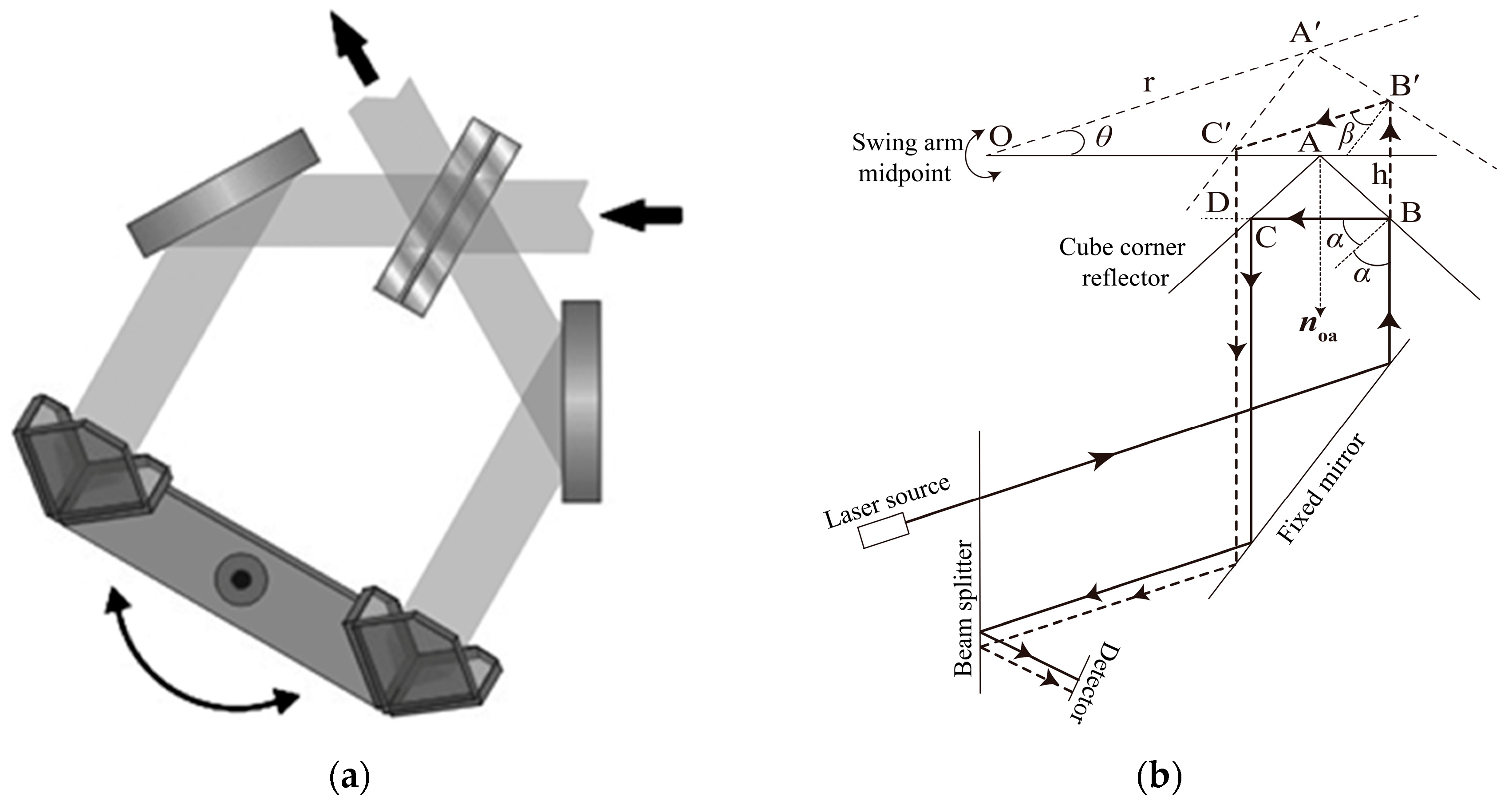
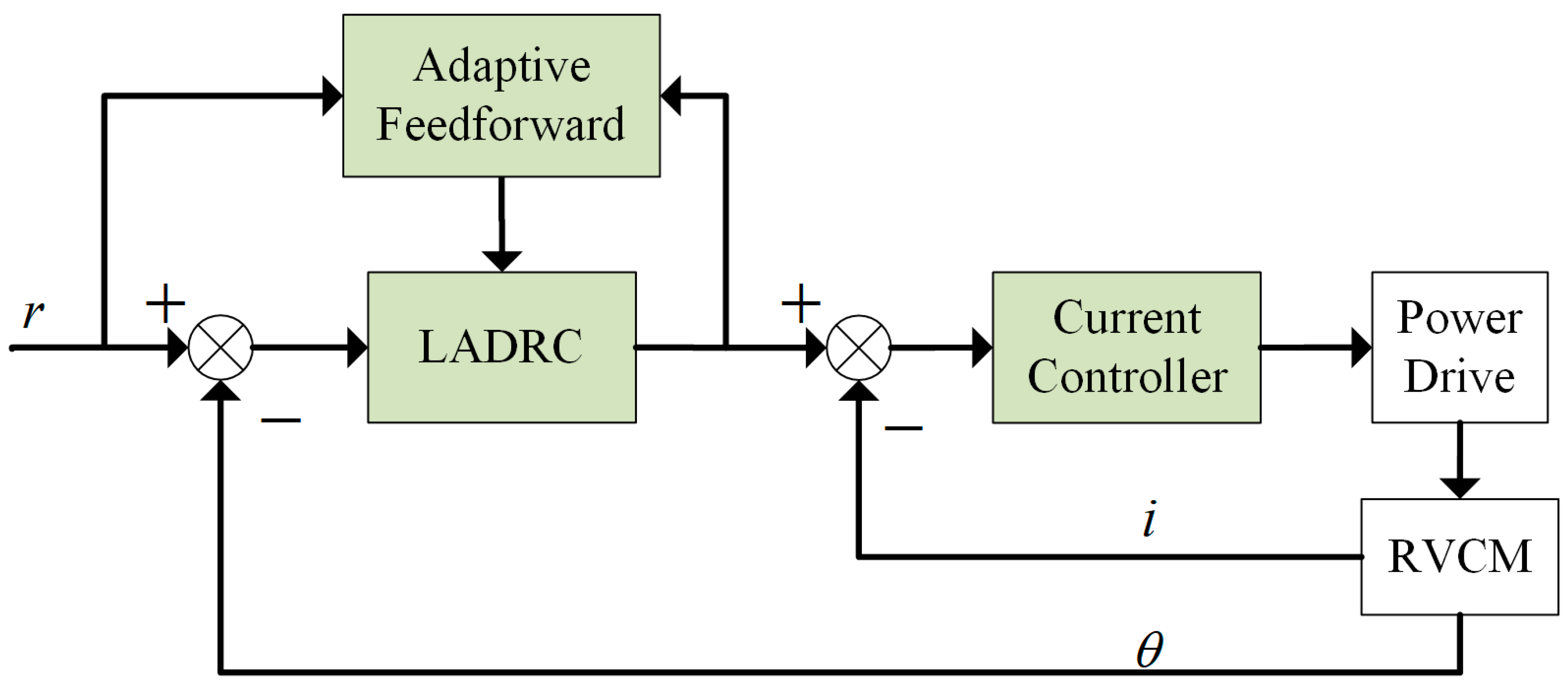


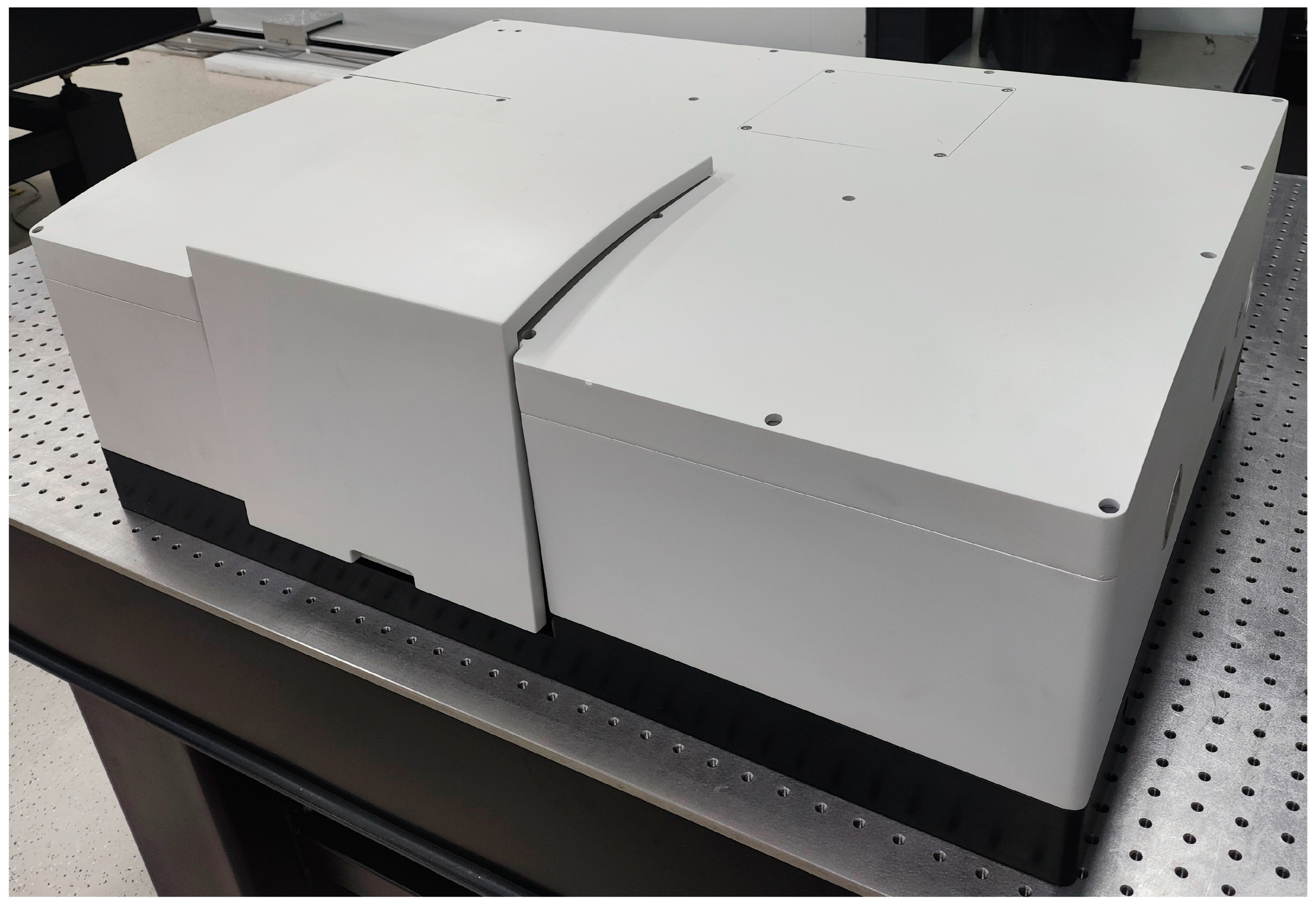



| Peak Position (cm−1) | Absolute Strength | FWHM (cm−1) |
|---|---|---|
| 2169.579 | 2.186 | 0.2420 |
| 2103.636 | 2.077 | 0.2484 |
| 2190.402 | 2.08 | 0.2496 |
| 2154.966 | 2.092 | 0.2513 |
| 2111.905 | 2.117 | 0.2514 |
| 2158.682 | 2.146 | 0.2518 |
Disclaimer/Publisher’s Note: The statements, opinions and data contained in all publications are solely those of the individual author(s) and contributor(s) and not of MDPI and/or the editor(s). MDPI and/or the editor(s) disclaim responsibility for any injury to people or property resulting from any ideas, methods, instructions or products referred to in the content. |
© 2025 by the authors. Licensee MDPI, Basel, Switzerland. This article is an open access article distributed under the terms and conditions of the Creative Commons Attribution (CC BY) license (https://creativecommons.org/licenses/by/4.0/).
Share and Cite
Zhi, L.; Han, W.; Yuan, S.; Luo, F.; Gao, H.; Zhang, Z.; Huang, M. Design of Ultra-Wide-Band Fourier Transform Infrared Spectrometer. Optics 2025, 6, 7. https://doi.org/10.3390/opt6010007
Zhi L, Han W, Yuan S, Luo F, Gao H, Zhang Z, Huang M. Design of Ultra-Wide-Band Fourier Transform Infrared Spectrometer. Optics. 2025; 6(1):7. https://doi.org/10.3390/opt6010007
Chicago/Turabian StyleZhi, Liangjie, Wei Han, Shuai Yuan, Fengkun Luo, Han Gao, Zixuan Zhang, and Min Huang. 2025. "Design of Ultra-Wide-Band Fourier Transform Infrared Spectrometer" Optics 6, no. 1: 7. https://doi.org/10.3390/opt6010007
APA StyleZhi, L., Han, W., Yuan, S., Luo, F., Gao, H., Zhang, Z., & Huang, M. (2025). Design of Ultra-Wide-Band Fourier Transform Infrared Spectrometer. Optics, 6(1), 7. https://doi.org/10.3390/opt6010007






